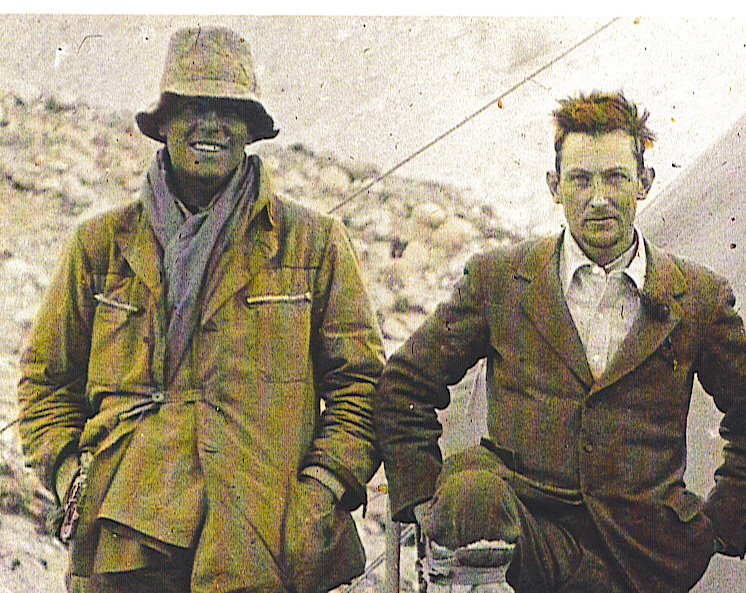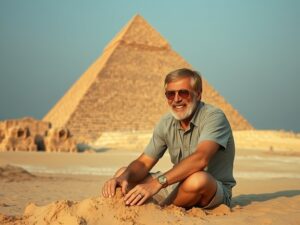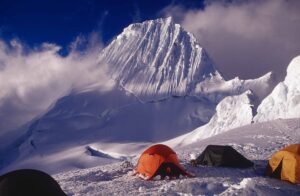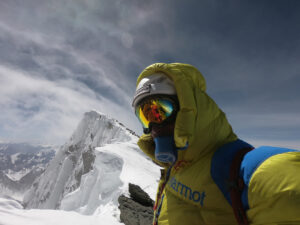100 years ago, two audacious and formidable mountaineers, one iconic British climber, George Leigh Mallory, and one young promising engineer, Andrew “Sandy” Irvine, sat out on their last attempt aiming for the top of the world – Mount Everest. A century later the mystery surrounding their fateful epic climb keeps us spellbound pondering whether or not they made it to the top as the first people ever, a feat so astonishing that it should reverberate for centuries to come. Did they reach the top, and have we finally come to a conclusion, a conclusion that unfortunately echoes a conspiracy of Hollywood proportions?
By Fredrik Sträng
“For the stone from the top for geologists, the knowledge of the limits of endurance for the doctors, but above all for the spirit of adventure to keep alive the soul of man.” ― George Mallory
8 June 1924 – What you must understand is that what was lying in front of these two intrepid British climbers was the big unknown. Unlike todays 4G signal on top of Everest, with every rock has been turned and mapped with Google Earth, and where today fixed ropes, waterproof down and limitless supplemental oxygen makes it a pleasurable “hike” to the roof of the world, the twenties displayed an aspect drenched with the unknown. They were dressed in eight layers of wool and cotton, the state-of-the-art technology developed by Burberry in London and where it took months for Mallory’s bellowed Ruth could receive news of the eventual success. The britts had lost the race to both the south and the north pole. They sure as hell was not going to lose the race for the so called “third pole”. Mallory was the only member who had been on all three British expeditions to Everest, one in 1921, and one in 1922. He was now 38 years old and he was not going to let this opportunity slip away.
“I cannot see myself coming down defeated … And I cannot tell you how it possesses me.” ― George Leigh Mallory
Mallory and Irvine woke up this morning in their rigid and damp tent. They were freezing their butts off, but nothing could stand in their way to search for fame and glory that awaited them should they return from the summit. They ventured out with wooden axes, clumsy and leaking oxygen apparatus (even tough Irvine had made significant improvements on the systems) and attached with a hemp rope. They were last seen by Noel Odell who until his deathbed was certain that he had seen them walking with alacrity on top of second step (the most technically difficult section on the route to Everest on the north side). They were never seen again alive, and news of their death reached Ruth as she was pruning her garden. She did not tell the children about the sad news that evening but waited until the morning. They all hugged each other and cried in the bed.
1933 – It wasn’t until 1933 that a British expedition went back to Everest. They highpoint made by Percy Wyn-Harris included finding an ice-axe on the northeast ridge at 8 460 m altitude with the marking “Irvine”. The ice-ace was staining up-right as if placed against a rock. Did it mark the way down for Mallory and Irvine or perhaps the location of an accident?
1953 – On the 29th of May 1953, a New Zeeland born beekeeper named Edmund Hillary and one Nepalese climber named Tenzing Norgay officially became the first to summit Everest. Hillary took the iconic picture of Tenzing posing with his ice-axe and the rest of the time he spent scrutinizing the summit for evidence that Mallory had been there before them, but he could not find anything.
1960 – Wang Fu-chou, Chu Yin-hua from the People’s Republic of China, and one Tibetan called Gonpa allegedly climbed Everest from the north in a long-disputed trial that involved summiting in pitch black conditions and without photographic proof. Decades later their questioned claim has gained approval from the western community and certain apologies but what is more astounding is the discovery that climber Xu Jing who abandoned his summit bid made on the way down at around 8460 m altitude. In a crevice on the treacherous and unforgiving steep slopes Xu Jing saw a frozen body who was resting inside a cave. It wasn’t until 2001 when German geologist Jochen Hemmleb and expedition leader Eric Simonson learnt about the discovery when they were interviewing members from the CTMA (Chinese Tibetan Mountaineering Association). This could be no other person than Andrew Irvine which we later will understand.
1975 – Since the Chinese 1960 claim of reaching Everest was disputed, they went back in 1975 and this time they made sure they got their summit photo. This was also the time when Phanthog became the second woman to reach the top. It was during this expedition that the Chinese climber Wang Hung-bao took a stroll out from camp VI at around 8100 m altitude that he came across “an English dead”. He later told this to a Japanese climber before Wang Hung-bao tragically lost his life on Everest in an avalanche.
1995 – A young Nepalese Sherpa named; Chhiring Dorje Sherpa came across Irvine when he descended a more direct line from the north-east ridge. Chhiring who was superstitious and a bit shocked about the frozen corpse with old garments in the cave did not know about the ill fated mystery of Mallory and Irvine so he disappeared quickly from the spot, not bothering to look for a camera, a Kodak Vest pocket camera that most likely Irvine was carrying to photograph his mentor and legend George Mallory. Chhiring did not speak of the event until many years later and his witness report led to speculation where exactly he had seen Irvine.
1999 – There had been previous attempts in the 80ties to search for Mallory and Irvine but non had such in depth knowledge pointing to where Irvine likely would be. A devoted Everest historian, Jochen Hemmleb’s research led to a search area when Wang Hung-bao’s testimony was cross-examined with pictures taken from Chinese 1975 camp VI. In 1999 a huge expedition with rigorous funding, two TV-teams and talented climbers went to Everest to track down Irvine. It was believed that Irvines ice-axe was above the probable resting place of Irvine some hundred meters below. On 1st of May 1999 Conrad Anker made the remarkable discovery that spread like a wildfire across media around the world. They did not find Irvine but Mallory.
His athletic body was preserved in the artic environment. His face was down in the gravel and his hands had dug themselves deep into the rocks as if stopping a fall. The hemp rope around his waist was broken and must have snapped during the fall. His right leg was broken, and his left leg was resting on top of trying to protect it. The search team looked in his pockets. His sunglasses were inside his jacket meaning that he must have descended in the dark. His watch was broken, and the arrows were gone. Rust witnessed that the watch had stopped at 5 minutes past 5. But was it five in the afternoon or five in the morning? The team was hoping to find a camera on Mallory, a Kodak Vest pocket camera that could contain proof of their summit success. If the camera was intact, Kodak in London deemed it possible to develop the film. But no camera could be found on or around him. They even searched with metal detectors but could not find any more items.
One vital item was missing though. A photo of his bellowed wife Ruth that according to their daughter Clarie Mallory was destined to be placed on the summit as a token of his love for his wife.
2020 – A National Geographic explorer named, Mark Synnott, together with a strong Sherpa team organized by Jamie McGuinness embarks on an attempt to finally track down Irvine’s resting place. They are investigating an old conviction based on that a high-resolution satellite image taken by aerial photographer Brad Washburn contains a black dot inside a cave. “It must be Irvine!”, said Tom Holzel who is a mountaineer and historian who dedicated much of his life to researching the disappearance of George Mallory and Andrew Irvine during their 1924 Everest expedition.
When Mark got descended to the cave people were hoping to close an almost 100-year-old chapter, and perhaps the greatest adventure mystery of all time. But, Irvine was not there. There was nothing there. The disappointment was final.
The aftermath – It seems like neither Mallory nor Irvine is on the mountain any longer.
“Irvine’s body is almost certainly no longer up there,” said McGuinness. “We gave it a good search with drones, and we spotted several other bodies, so we know we weren’t missing anything of the right size.”
McGuinness says that while at base camp in 2012 he asked a China Tibet Mountaineering Association official whether Irvine’s body had been removed for the Olympics. “He replied: ‘It was thrown off the mountain a lot earlier than that.’
Interviews with CTMA officials deduce that a camera was found and that the Chinese tried indeed to develop the film, but it was unsuccessful. No official statement on the matter has been released and why should they? China has all the reasons to cover up the story if they so like, because if Mallory and Irvine did reach the summit that would downplay the Chinese achievement from 1960 to second place. The fact that Irvine and Mallory’s whereabouts and findings are kept a secret further instils the theory that they did reach the summit.
It is heartbreaking to learn that the only few proofs that could determine once and for all Mallory and Irvine’s fate are now destroyed and buried. Do I think that Mallory and Irvine would have loved the world to learn about their final hours and if they made it to the top? I do. But now we will never know due to politics and pride.
As a boy, I was mesmerized by the tales of Mallory and Irvine. It kept me awake late at night and I tried to solve the riddle inside my mind, trying to imagine their final hours high on the remorseless slopes of Everest. As Edmund Hillary once said, even if Mallory did reach the summit, part of the equation is getting down alive again so that only makes Hillary and Tenzing the first to climb up and down.
Nevertheless, humans are infatuated with mysteries, because it breaks our daily routines and is a welcoming break to the ordinary that can be comfortable but seldom makes us feel alive. Mysteries gives a glimpse of that there are still puzzles to be solved and wonders to be adored. Somehow, I hold on to a wish that they did reach the top, that they deserved it, and perhaps some mysteries should not be solved. For what if there were proof that they did not reach the summit? Then the magic would end a powerful chapter in the history of adventure.
Claire always said that Mallory would leave a photo of Ruth on top of Everest as a token of his love for his wife. So where is the image?
About Fredrik Sträng: Fredrik, in his leadership role, has climbed seven of the Earth’s fourteen 8,000m peaks, set a Guinness World Record, and lectures on leadership, communication, decision-making, and crisis management.
Best regards, Fredrik Sträng Alpinist – Speaker – Coach







